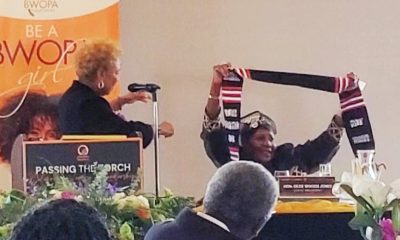Activism
Oakland’s Clergy Leaders Say ‘No’ Vote to Recall of Mayor Sheng Thao
“The recall of the mayor is not needed and ill-founded. Oakland does not need chaos. Oakland does not need coal dust in the air,” said Pastor Jim Hopkins of Lake Shore Avenue Baptist Church. The pastor was referring to recall funder and hedge fund partner Phillip Dreyfuss, whose company has several billions of dollars invested in the coal industry at a time when Oakland is resisting the construction of a coal export terminal in the city.

By Post Staff
Local faith leaders spoke out at a press conference this week at the Democratic Party Election Headquarters office in Oakland to express their support for Mayor Sheng Thao.
They also urged Oakland residents to vote “No” on the recall on the Nov. 5 ballot.
The leaders in this interfaith coalition, representing the diversity of Oakland’s religious community, organized the press conference on Oct. 22 to show they are standing united against the recall. Speakers said they were concerned that a successful recall would throw the city and its finances into chaos.
If the recall were successful, the city would have five mayors in three years, creating dysfunction at a time the city desperately needs stable leadership to focus on its budget and continue to make progress on public safety, the leaders emphasized.
“The recall of the mayor is not needed and ill-founded. Oakland does not need chaos. Oakland does not need coal dust in the air,” said Pastor Jim Hopkins of Lake Shore Avenue Baptist Church.
The pastor was referring to recall funder and hedge fund partner Phillip Dreyfuss, whose company has several billions of dollars invested in the coal industry at a time when Oakland is resisting the construction of a coal export terminal in the city.
“I love Oakland, and we need to get behind our leadership. I’m excited we have a mayor who is concerned about the people of Oakland,” said Bishop Greg Payton of St. John’s Missionary Baptist Church in West Oakland.
Said Pastor Joe Smith of Good Hope Baptist Church in East Oakland, “Our homicides are down. Police force not fully staffed. She has the rate down. Black and Brown boys not getting killed. Mayor Thao has done this. United we stand, divided we fall. I’m here to say ‘No’ on the recall. I don’t believe in recalls. We have a good Mayor. Let’s stand with her.”
Speaking at the press conference, Mayor Sheng Thao said she has taken major steps to increase public safety, significantly reducing crime in the city. In addition, Thao added. “In less than two years, I’ve already invested in West Oakland, and in Deep East Oakland, (and) new investments are set to bring billions to the city,” Mayor Thao said
Many community organizations and leaders have stood with the mayor since the “No on the Recall” campaign launched on Oct. 6.
Those opposing the recall include the Alameda County Democratic Party, Rep Barbara Lee (D-CA-12), Sen. Nancy Skinner (D-Berkeley), Alameda County Supervisor Keith Carson, former Assemblymember Sandré Swanson, Oakland City Councilmember Carroll Fife, Oakland City Councilmember Dan Kalb, and 12 of the 16 candidates running for Oakland City Council.
In addition, a range of unions and political organizations have taken a stand against the recall effort, including the Alameda Labor Council, SEIU 1021, IFPTE Local 21, Alameda County Fire Fighters, NorCal Carpenters Union, as well as Oakland Rising Action, APEN (Asian Pacific Environmental Network), John George Democratic Club, Wellstone Democratic Club, the Latino Task Force, and others.
Activism
Oakland Post: Week of November 26 – December 2, 2025
The printed Weekly Edition of the Oakland Post: Week of November 26 – December 2, 2025
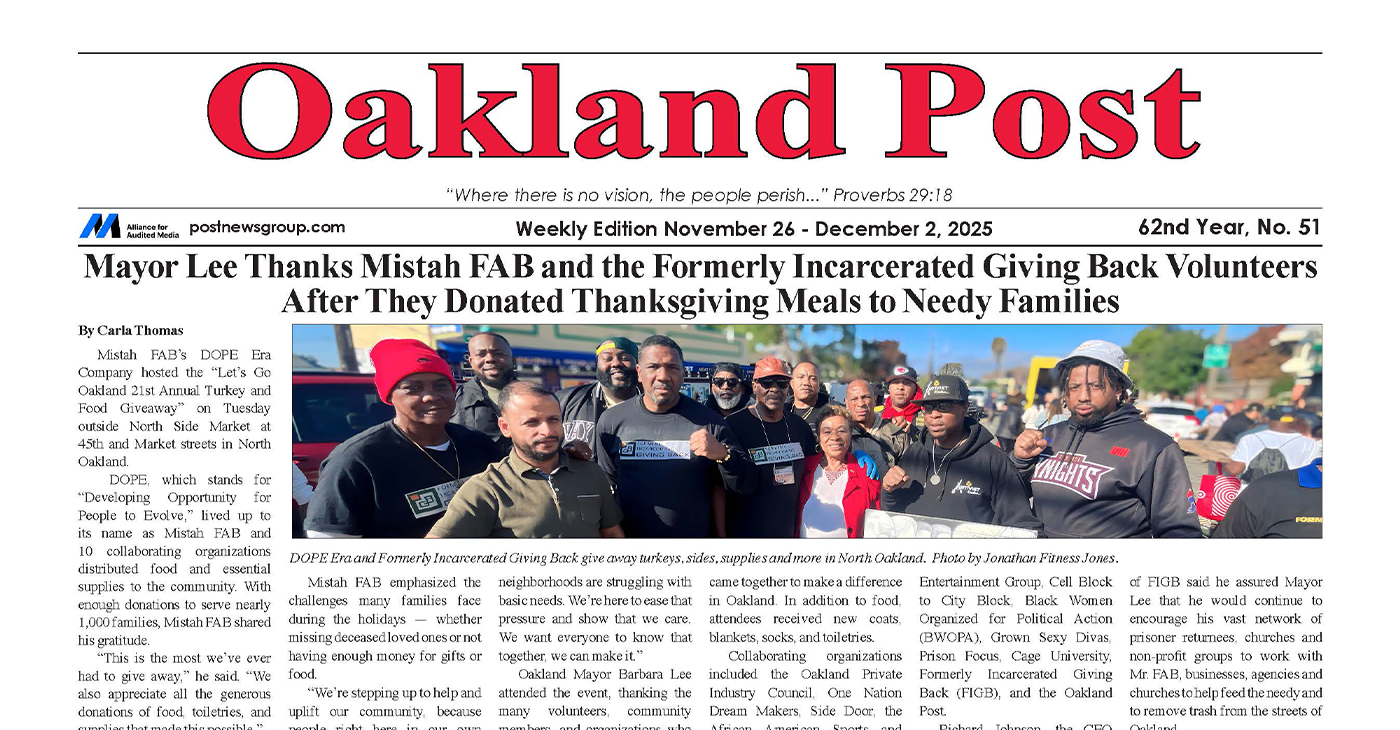
To enlarge your view of this issue, use the slider, magnifying glass icon or full page icon in the lower right corner of the browser window.
Activism
Oakland Post: Week of November 19 – 25, 2025
The printed Weekly Edition of the Oakland Post: Week of November 19 – 25, 2025
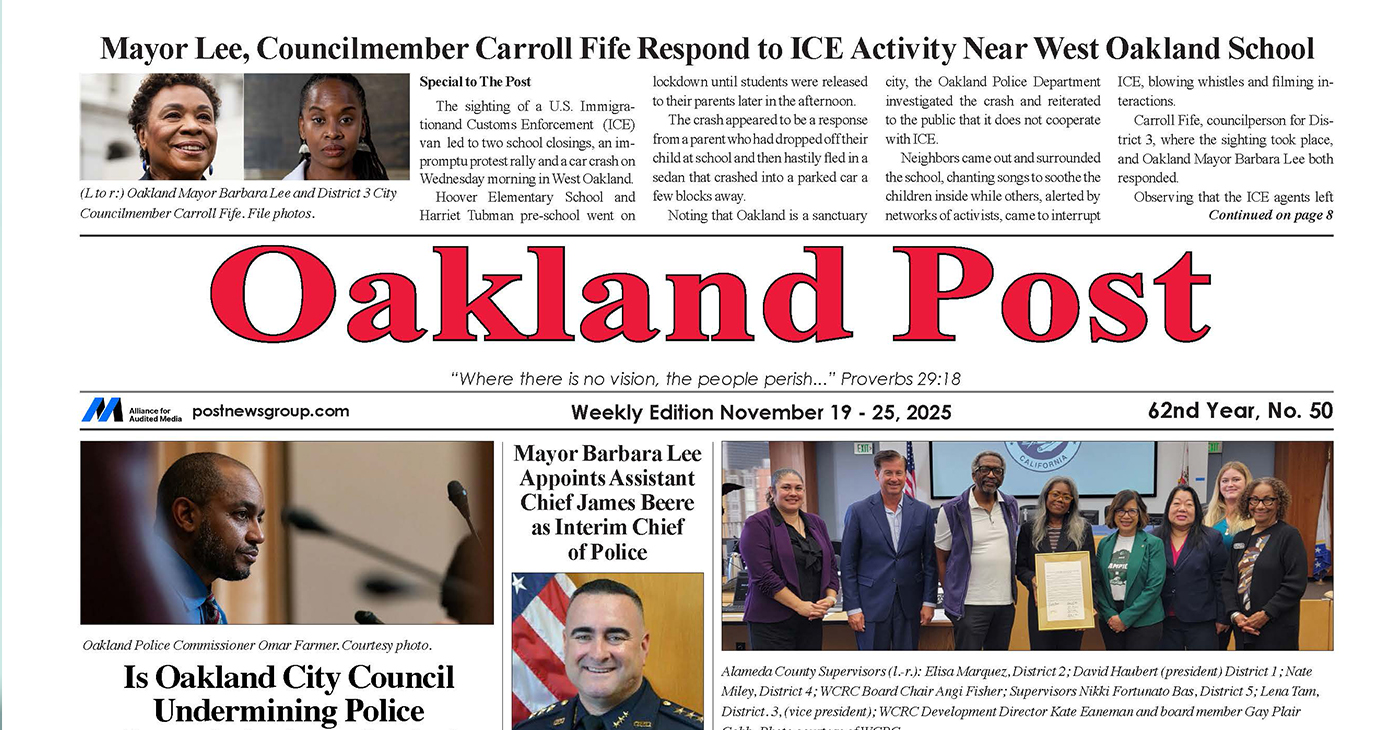
To enlarge your view of this issue, use the slider, magnifying glass icon or full page icon in the lower right corner of the browser window.
Activism
IN MEMORIAM: William ‘Bill’ Patterson, 94
Bill devoted his life to public service and education. In 1971, he became the founding director for the Peralta Community College Foundation, he also became an administrator for Oakland Parks and Recreation overseeing 23 recreation centers, the Oakland Zoo, Children’s Fairyland, Lake Merritt, and the Henry J. Kaiser Convention Center.
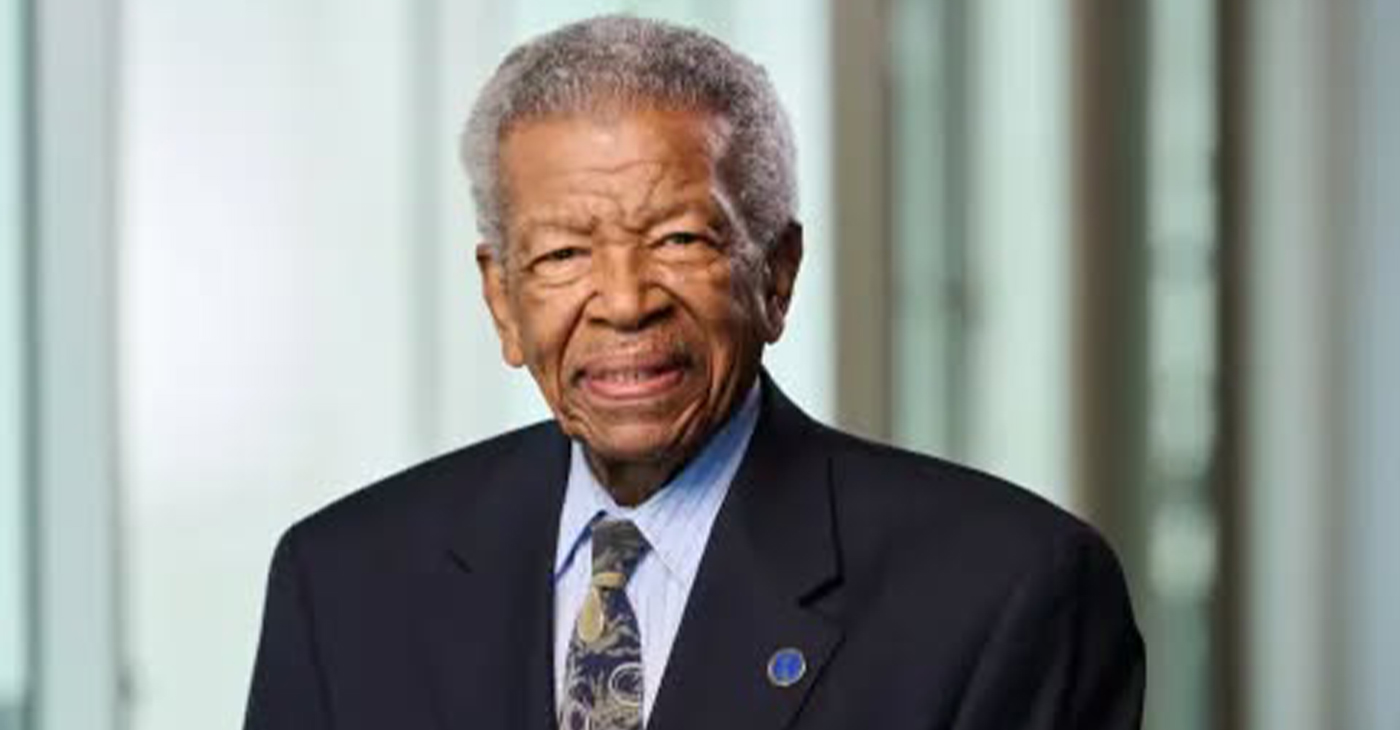
William “Bill” Patterson, 94, of Little Rock, Arkansas, passed away peacefully on October 21, 2025, at his home in Oakland, CA. He was born on May 19, 1931, to Marie Childress Patterson and William Benjamin Patterson in Little Rock, Arkansas. He graduated from Dunbar High School and traveled to Oakland, California, in 1948. William Patterson graduated from San Francisco State University, earning both graduate and undergraduate degrees. He married Euradell “Dell” Patterson in 1961. Bill lovingly took care of his wife, Dell, until she died in 2020.
Bill devoted his life to public service and education. In 1971, he became the founding director for the Peralta Community College Foundation, he also became an administrator for Oakland Parks and Recreation overseeing 23 recreation centers, the Oakland Zoo, Children’s Fairyland, Lake Merritt, and the Henry J. Kaiser Convention Center.
He served on the boards of Oakland’s Urban Strategies Council, the Oakland Public Ethics Commission, and the Oakland Workforce Development Board.
He was a three-term president of the Oakland branch of the NAACP.
Bill was initiated in the Gamma Alpha chapter of Kappa Alpha Psi Fraternity.
In 1997 Bill was appointed to the East Bay Utility District Board of Directors. William Patterson was the first African American Board President and served the board for 27 years.
Bill’s impact reached far beyond his various important and impactful positions.
Bill mentored politicians, athletes and young people. Among those he mentored and advised are legends Joe Morgan, Bill Russell, Frank Robinson, Curt Flood, and Lionel Wilson to name a few.
He is survived by his son, William David Patterson, and one sister, Sarah Ann Strickland, and a host of other family members and friends.
A celebration of life service will take place at Henry J. Kaiser Convention Center (Calvin Simmons Theater) on November 21, 2025, at 10 AM.
His services are being livestreamed at: https://www.facebook.com/events/1250167107131991/
In lieu of flowers, donations can be made to the Euradell and William Patterson scholarship fund TBA.
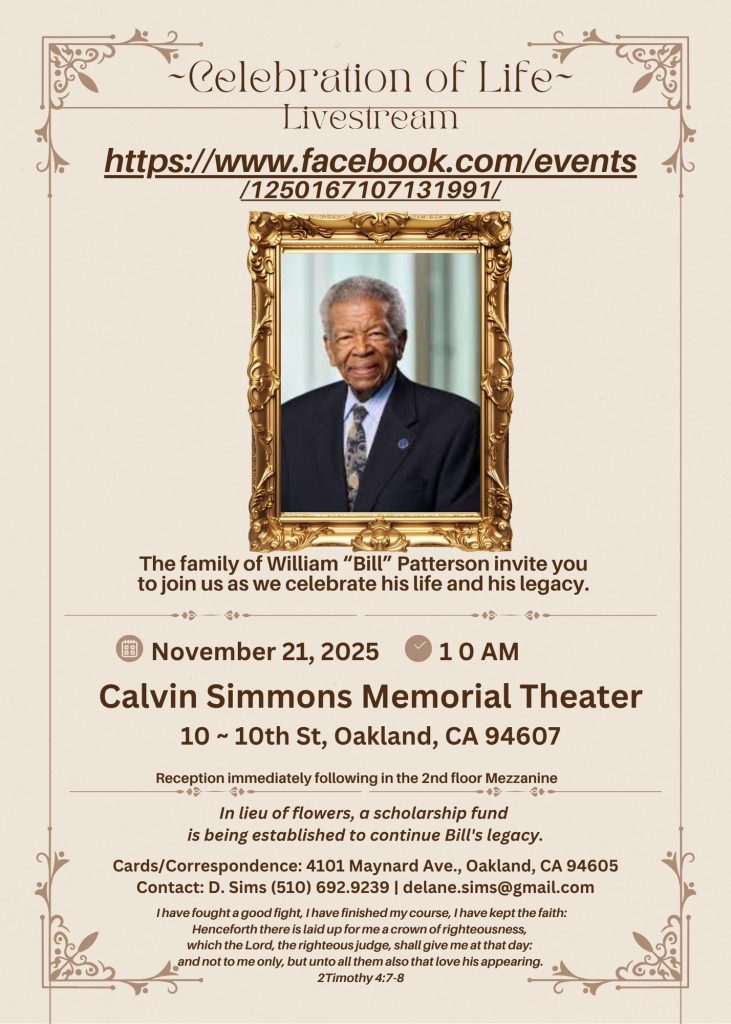
-

 Activism3 weeks ago
Activism3 weeks agoOakland Post: Week of November 12 – 18, 2025
-
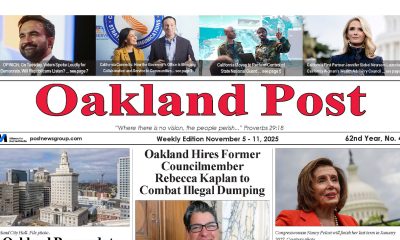
 Activism4 weeks ago
Activism4 weeks agoOakland Post: Week of November 5 – 11, 2025
-

 Activism2 weeks ago
Activism2 weeks agoIN MEMORIAM: William ‘Bill’ Patterson, 94
-

 Activism3 weeks ago
Activism3 weeks agoHow Charles R. Drew University Navigated More Than $20 Million in Fed Cuts – Still Prioritizing Students and Community Health
-

 #NNPA BlackPress3 weeks ago
#NNPA BlackPress3 weeks agoThe Perfumed Hand of Hypocrisy: Trump Hosted Former Terror Suspect While America Condemns a Muslim Mayor
-

 Bay Area3 weeks ago
Bay Area3 weeks agoNo Justice in the Justice System
-

 #NNPA BlackPress3 weeks ago
#NNPA BlackPress3 weeks agoProtecting Pedophiles: The GOP’s Warped Crusade Against Its Own Lies
-

 #NNPA BlackPress2 weeks ago
#NNPA BlackPress2 weeks agoTrump’s Death Threat Rhetoric Sends Nation into Crisis









